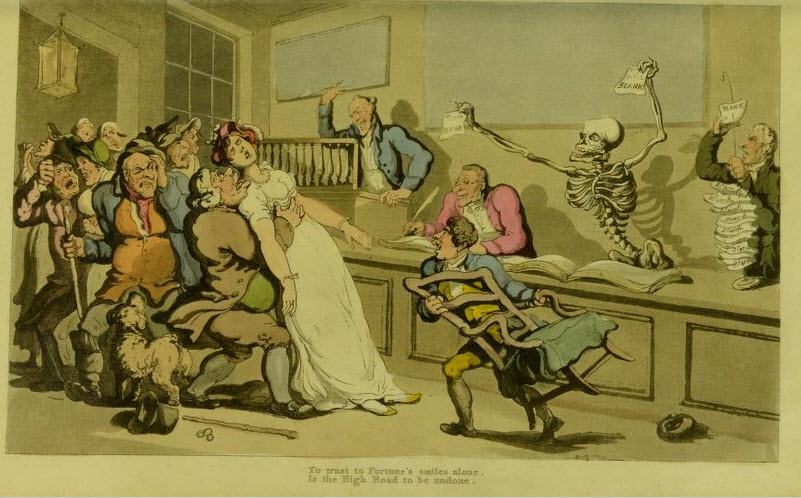
Thomas Rowlandson (born July 14, 1756 - died April 21, 1827) was an English illustrator and caricaturist. Born in London, the son of a merchant, Rowlandson moved to Paris at age 16, with an uncle, where he entered the French Academie Royale of Art, under the sponsorship of Pigalle, the famous French sculptor. After completing his artistic education, Rowlandson returned to London but continued to make frequent trips to the Continent which he used to enrich and build his sketchbook of character studies and drawings.
By the time he was 22, Rowlandson was enjoying artistic and financial success as a portrait painter. It is likely that he would have continued in this line of work if not for the death of a French aunt, which resulted in Rowlandson inheriting the substantial amount of money. Rowlandson used this inheritance to bankroll an attempt to become a professional gambler, but he lost all of his money and was ruined financially.
To earn money, Rowlandson turned to producing satirical sketches and caricatures as well as a series of erotic woodcuts and etchings which were a commercial success. Rowlandson's drawings were first drawn in pen (quill), before being finished with a wash of color. They were then engraved by the artist on a copper plate. The prints were then hand-colored.
Rowlandson focused on illustrating and lampooning aspects of everyday life and society, and for the most part stayed away from political issues or commentary. However, around 1790, he began drawing and developing the cartoon character named John Bull, an allegorical personification of England, which served as patriotic political propaganda during England's long rivalry with France. His work on John Bull coincided with similar work by the artists George Cruikshank and James Gilray, who also contributed to the development of the John Bull character.
His Dance of Death represents a modernization of the allegory and it is interesting to contrast his depiction of th motif with Holbein's woodcuts on the same subject. In Holbein, the message is more earnest and religious, focusing on the transitory nature of life and the need to repent before it is too late. Although there is an element of humor and satire in Holbein, it is focused on the dangers of vanity and pride. In Rowlandson's version, the religious element is non-existent and the same motif is used primarily to poke fun at or caricature various aspects of British society in the mid 1800s. In addition to a difference in focus between the two artists there is obviously a significant difference in technique. Holbein's woodcuts are primitive, while Rowlandson's drawings are in detaled and in color, representing a shift in style as well as advances in printing technique and in the evolution of popular culture.

The Quack Doctor: Death Is Busy Mixing the Potions Which the Gullible Patients Will Buy
Rowlandson is connected to the Dance of Death genre as a result of his illustrations for a book called the English Dance of Death, which was published in installments between 1814 and 1816. These drawings borrow the familiar motif of the Dance of Death, namely the personification of death leading unwilling or unsuspecting persons from various social classes and conditions to their death, but applies them to British situations and stereotypes.

To trust in fortune's smiles alone/ Is the High Road to be undone.
Although Death is ever present in these drawings, Rowlandson's Dance of Death differs greatly from that of Holbein or earlier artists. The situations are of course different, reflecting British society in the early 1800s, but Death also is different. Rowlandson's Death appears cunning, sly, mean spirited, but rarely jolly. Despite the title, there is very little actual dancing in any of Rowlandson's drawings.